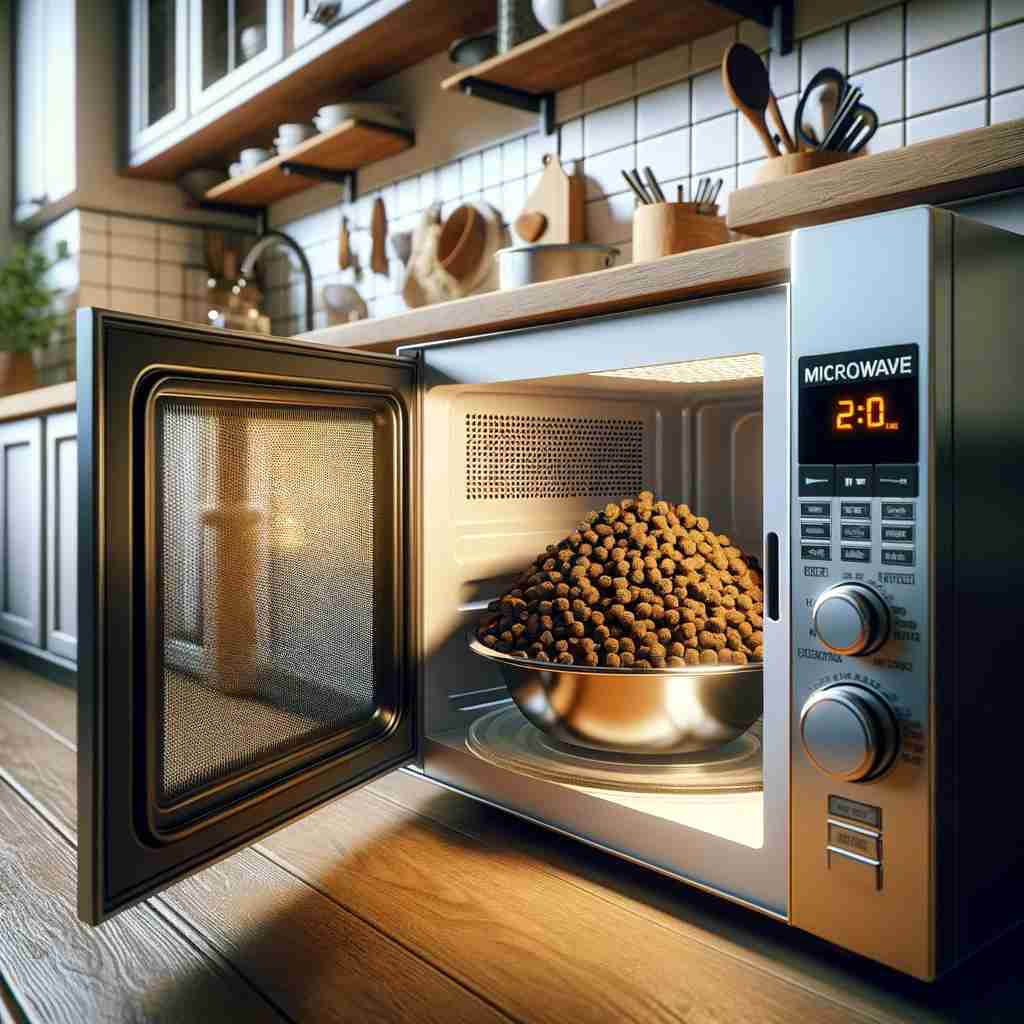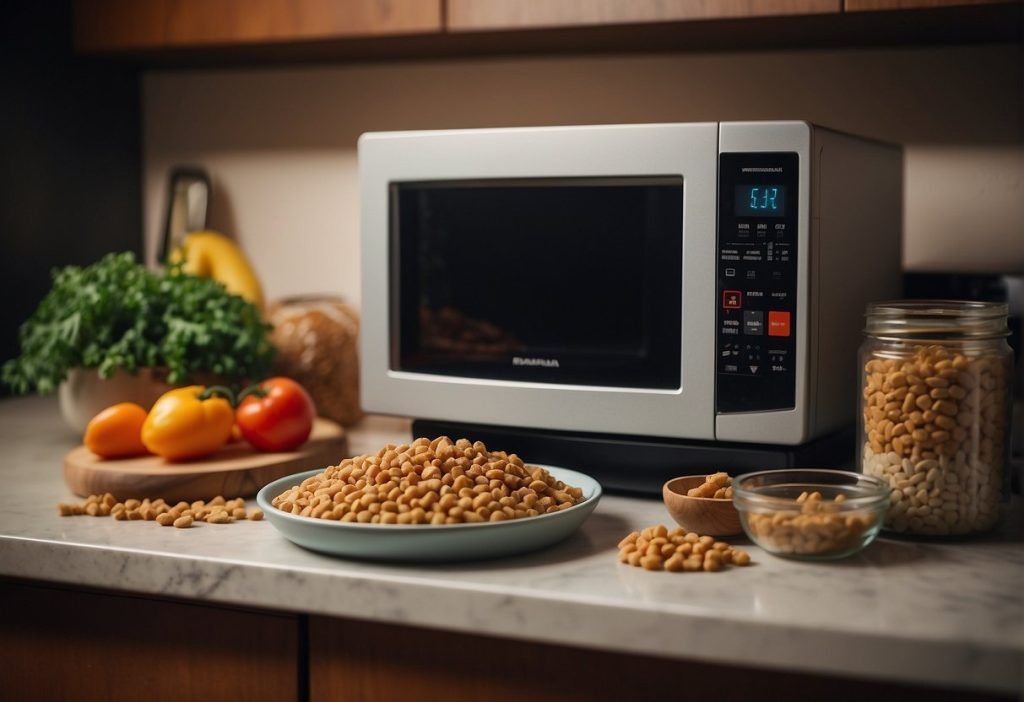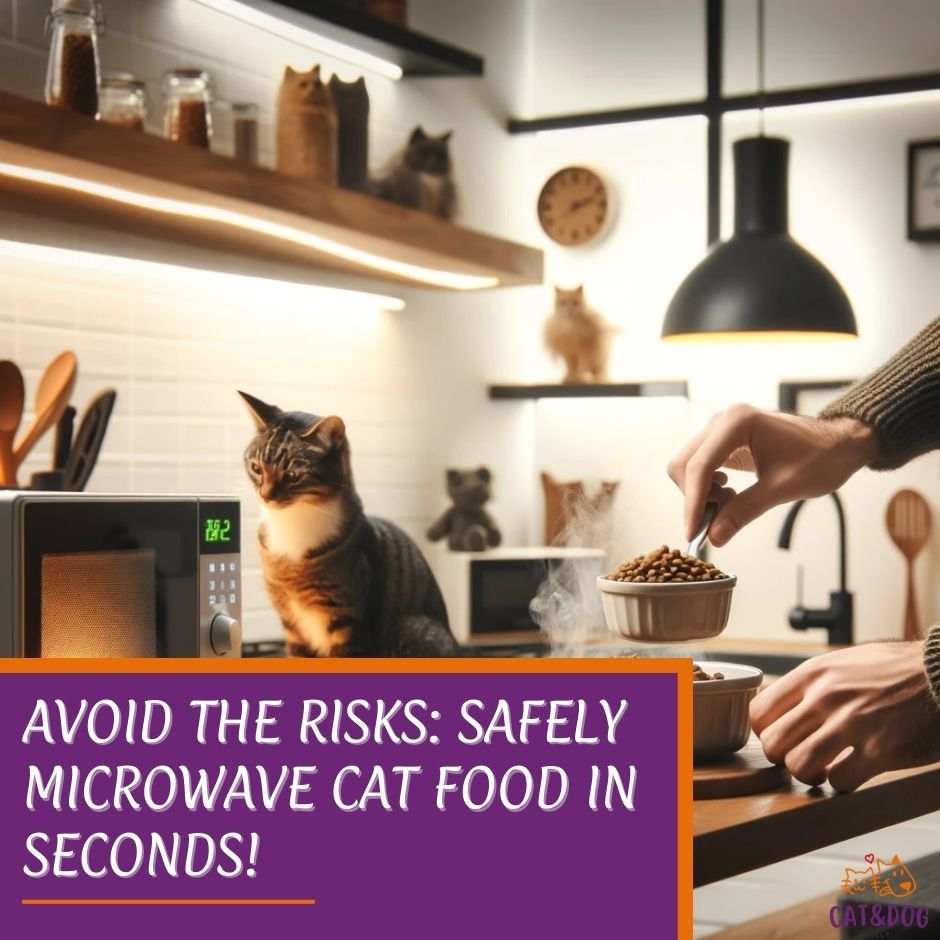You might wonder if it’s okay to microwave cat food when it comes to feeding your furry companion.
It’s a debate many cat owners encounter, weighing the convenience of a quick warm-up against the unknowns of potential health risks.
You know how finicky cats can be with their food – they often prefer it at just the right temperature, similar to their natural prey.
But is microwaving the best method to achieve that purr-fect warmth and stimulate your cat’s appetite? One problem you may experience is that cold food doesn’t give off much odor.
Cats are already very picky about their food, so if you offer cold food, the aromas will not be very strong and this may not stimulate your cat’s appetite. (1)
This is the reason why quickly heating it in the microwave is a good idea.
Microwave use is commonplace for heating human food, but does the same apply to cat food?
While many believe that popping the cat’s dinner into the microwave is a quick fix, myths and misconceptions are swirling around its safety.
These tales range from destroying nutrients to the fear of hot spots that could harm your pet.
But rest easy, we’re here to separate fact from fiction and ensure that your cat’s health and mealtime satisfaction stay at the forefront.
Better go back to commercial small kibble to avoid the risks associated with microwaving cat food in seconds!
Key Takeaways
- Microwave cat food is a common practice, but it’s essential to do it safely to preserve nutrients and avoid hot spots.
- It’s important to understand the potential risks of microwaving and explore nutritious alternatives to ensure your cat’s well-being.
- Always consider your cat’s preferences and health needs when choosing how to serve their meals.
Microwave Cat Food: A Comprehensive Guide

Ever wonder if it’s okay to pop your cat’s dinner in the microwave? You’re not alone. Cats need a balanced diet rich in protein, fats, vitamins, and minerals, just like any fine connoisseur. (2)
But when it comes to heating that gourmet meal, you might hit a snag.
Here’s the scoop on the risks of microwaving:
- Uneven heating can make some parts too hot, risking burns to your kitty’s mouth.
- Scientists have noted that microwaving might alter some nutrients, although the verdict on how significantly this affects the food’s nutritional value is still out. (3)
Now, onto the meaty details of nutrition:
- Cooking, including microwaving, can degrade certain vitamins, like Vitamin C. (4)
- A chat with your vet or a pet nutritionist might shed light on how your specific brand fares after a spin in the nukebox.
No research data? No problem! We’re focusing on what’s known, keeping it real without the fluff. Nutrition is key, after all.
Here’s how to ensure safety while microwaving that chow:
- Check the label for microwave instructions or warnings.
- Stir well after heating to avoid hotspots.
- Test the temperature before serving to your cat.
Remember, this is all about giving your feline friend a safe and nutritious meal. They say curiosity killed the cat, but in this case, it just might lead to a better dining experience!
Stay informed, and always provide delicious and nutritious food to your kitty, bon appétit to your kitty!
Safe and Nutritious Alternatives to Microwaving

Ever faced the dilemma of warming up your feline friend’s food? Microwaves can be a tad harsh, so why not try a gentler approach? Let’s talk room-temperature magic.
All it takes is planning! Remove a portion of your cat’s food from the fridge and let it sit for about 30 minutes to an hour – this will allow it to gently reach a more palatable temperature.
Your furry companion won’t have to wait too long for their meal, and you won’t risk altering the food’s quality.
It can be a good idea to warm your cat’s food to room temperature before serving it, as this can healthily simulate the prey instinct and make it significantly more appetizing to your cat. (5)
But what if you forgot to plan ahead? No woes. The warm water trick has got your back. Here’s how to execute it perfectly:
- Place the cat food can or pouch in a bowl.
- Pour warm (not hot!) water around the food container.
- Let it sit for a few minutes, giving it a gentle shake now and then to evenly distribute the warmth.
Best Practices for Serving Refrigerated and Wet Cat Food
While exploring safe heating methods for your cat’s food, it’s also important to choose the right low-carb cat food to ensure a balanced and nutritious diet.
Perhaps you’re wondering about alternatives that still involve a bit of heat? A low-heat oven can come to the rescue.
Simply preheat your oven to the lowest setting, place your cat’s food in an oven-safe dish, and warm it for no more than 10-15 minutes.
This controlled method ensures no hot spots and a safe, uniform temperature throughout.
Remember, safety and hygiene go paw-in-paw! Always wash your hands before and after handling cat food to keep things clean.
Use clean spoils to serve the food, and never mix new food with old in your pet’s dish to avoid cross-contamination.
Armed with these tips, you can say goodbye to the microwave method and hello to happy, healthy mealtimes for your kitty.
Understanding Cat Preferences and Health Considerations

Ever wondered how your feline friend feels about their dinner’s temperature? Temperature can significantly affect both the taste and texture of cat food, much like how we might not enjoy cold pizza. (6)
Cats have specific preferences. For example, have you ever noticed your cat turning their nose up at food straight from the fridge, but gobbling it down after it’s been slightly warmed?
A case study on feline reactions to various food temperatures may shed light on this. Cats tend to prefer food at room temperature or a bit warmer, emulating the temperature of fresh prey.
Cold food can be off-putting and harder to taste, while too hot can risk harming their sensitive mouths. So, it can be a good idea to warm your cat’s food to room temperature before serving it.
This puts the food’s consistency back to normal and unlocks its aroma, making it significantly more appetizing to your cat and can healthily simulate the prey instinct.
Now, let’s talk about health and special dietary needs:
- Some cats have dietary sensitivities requiring specific temperatures.
- Elderly cats or those with dental issues may find warmer food easier to eat.
- Warmer food can release aromas that entice finicky eaters or those with poor appetite due to illness.
It’s always a safe bet to check with your veterinarian before making any significant changes to your cat’s diet. They can provide tailored advice, considering your cat’s health history.
Lastly, here’s a quick guide to follow for a happy, healthy kitty mealtime:
- Warm food in short intervals, stirring in between to evenly distribute heat.
- Avoid hot spots that could burn your cat’s mouth.
- Always test the temperature before serving.
Remember, the goal isn’t to cook the food but just to take the chill off. Your cat’s purrs of approval will thank you for your culinary efforts!
Conclusion: Ensuring Cat Health and Palatability
Have you ever pondered whether it’s a good move to microwave your feline friend’s food? Let’s quickly touch on the pros and cons to clear the air.
Pros:
- Warmth Equals Enticement: Slightly warming cat food can enhance its aroma, making it more appealing for picky eaters.
- Texture Improvement: Microwaving can soften food, which is great for cats with dental issues.
Cons:
- Hot Spots: Uneven heating can create spots that are too hot and might burn your cat’s mouth.
- Nutrient Loss: Excessive heat could degrade some nutrients, lessening the food’s nutritional value. (7)
It’s all about balance when it comes to your cat’s health and the yummy factor of their meals. Remember, safety first—always stir the food and test the temperature before serving.
Wondering about other resources? Here’s a quick list for you to paw through:
- Scientific Journals: Articles on feline nutrition give insights into the latest research.
- Veterinary Advice Sites: Websites like PetMD provide expert guidance on pet care.
And, of course, nothing beats a chat with your vet for tailored advice. Microwaving cat food can be a quick fix to tempt those finicky feline taste buds, but always keep your cat’s welfare at the forefront.
A warm meal of dry food might just be the purr-fect treat, but it’s crucial to ensure it’s safe and scrumptious too!
Frequently Asked Questions
Curious about microwaving your feline friend’s dinner? You’ve got questions, we’ve got answers! From safety to alternative warming methods, let’s tackle those top FAQ’s about microwaving cat food.
Is it safe to heat wet cat food in the microwave, and if so, for how long?
Yes, you can heat wet cat food in the microwave. Aim for short bursts of 5 seconds, stirring in between to avoid hot spots, until the food reaches a lukewarm temperature.
Can microwaving cat food destroy its nutrients?
Microwaving cat food can indeed lead to nutrient loss, especially if overheated. It’s best to warm the food gently to preserve its nutritional integrity.
What are some tips for safely preparing microwave-heated meals for cats?
For a safe microwave experience, always stir the food and check for hot spots. Transfer the food to a microwave-safe dish and avoid overheating to maintain nutrient levels.
Do cats prefer their food warm, and are there benefits to warming up their meals?
Many cats prefer their food warm as it mimics their natural prey’s temperature and can be more aromatic.
Warming up meals can also entice picky eaters or those with a weakened sense of smell.
What alternative methods can I use to warm cat food if I don’t have a microwave?
Without a microwave, place the food in a sealable bag and immerse it in warm water, or let it sit out at room temperature for a bit to take the chill off.
Are there any health risks to cats from eating microwaved food?
If not done correctly, microwaving can create uneven heating leading to hot spots that may pose a burn risk for your cat. Always ensure even heat distribution.
Is it safe to microwave cat food in plastic containers?
It’s crucial to only use microwave-safe containers to avoid any chemicals leaching into the cat food. Transfer the food to a glass or ceramic dish if in doubt.
- The Ultimate Overview to Actual Cash Gambling Establishments - July 1, 2025


